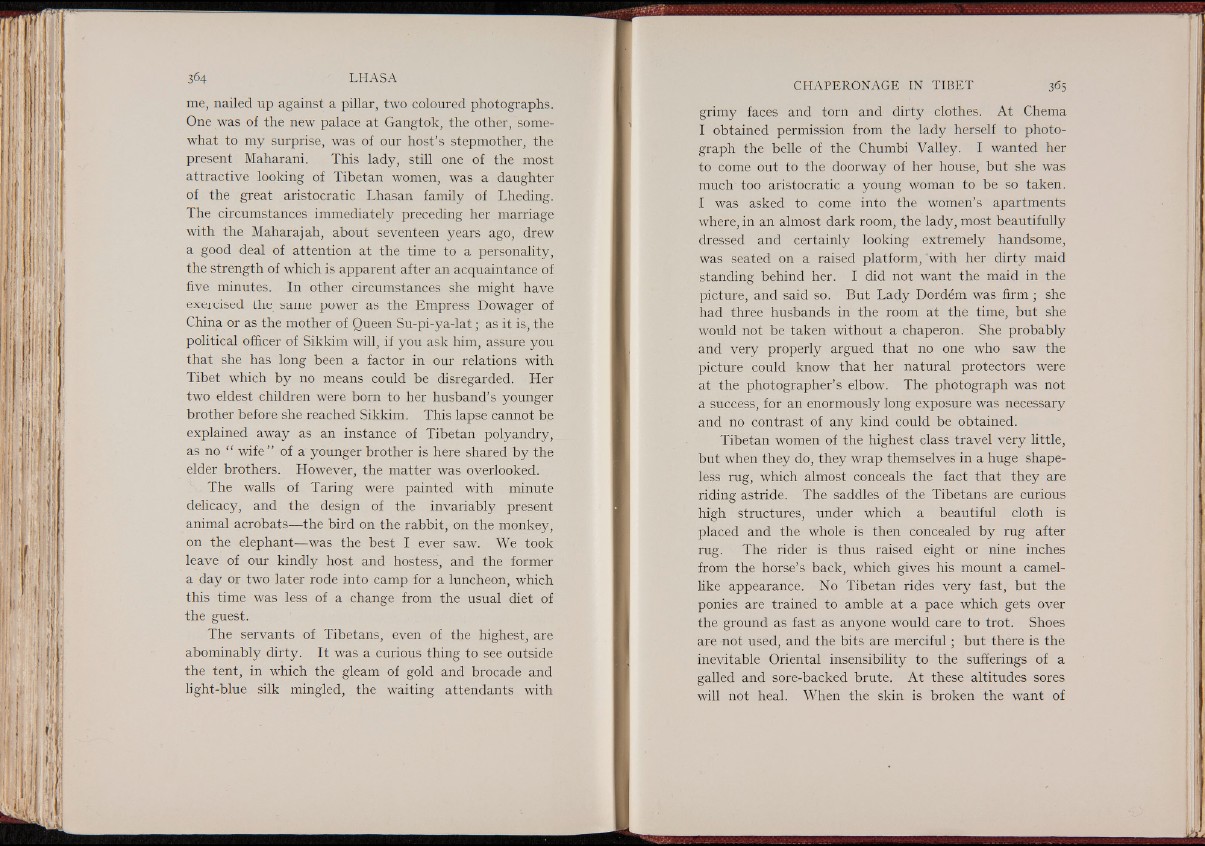
me, nailed up against a pillar, two coloured photographs.
One was of the new palace at Gangtok, the other, somewhat
to my surprise, was of our host’s stepmother, the
present Maharani. This lady, still one of the most
attractive looking of Tibetan women, was a daughter
of the great aristocratic Lhasan family of Lheding.
The circumstances immediately preceding her marriage
with the Maharajah, about seventeen years ago, drew
a good deal of attention at the time to a personality,
the strength of which is apparent after an acquaintance of
five minutes. In other circumstances she might have
exercised the same power as the Empress Dowager of
China or as the mother of Queen Su-pi-ya-lat § as it is, the
political officer of Sikkim will, if you ask him, assure you
that she has long been a factor in our relations with
Tibet which by no means could be disregarded. Her
two eldest children were born to her husband’s younger
brother before she reached Sikkim. This lapse cannot be
explained away as an instance of Tibetan polyandry,
as no “ wife” of a younger brother is here shared by the
elder brothers. However, the matter was overlooked.
The walls of Taring were painted with minute
delicacy, and the design of the invariably present
animal acrobats— the bird on the rabbit, on the monkey,
on the elephant— was the best I ever saw. We took
leave of our kindly host and hostess, and the former
a day or two later rode into camp for a luncheon, which
this time was less of a change from the usual diet of
the guest.
The servants of Tibetans, even of the highest, are
abominably dirty. It was a curious thing to see outside
the tent, in which the gleam of gold and brocade and
light-blue silk mingled, the waiting attendants with
grimy faces and torn and dirty clothes. At Chema
I obtained permission from the lady herself to photograph
the belle of the Chumbi Valley. I wanted her
to come out to the doorway of her house, but she was
much' too aristocratic a young woman to be so taken.
I was asked to come into the women’s apartments
where, in an almost dark room, the lady, most beautifully
dressed and certainly looking extremely handsome,
was seated on a raised platform, 'with her dirty maid
standing behind her. I did not want the maid in the
picture, and said so. But Lady Dordem was firm ■ she
had three husbands in the room at the time, but she
would not be taken without a chaperon. She probably
and very properly argued that no one who saw the
picture could know that her natural protectors were
at the photographer’s elbow. The photograph was not
a success, for an enormously long exposure was necessary
and no contrast of any kind could be obtained.
Tibetan women of the highest class travel very little,
but when they do, they wrap themselves in a huge shapeless
rug, which almost conceals the fact that they are
riding astride. The saddles of the Tibetans are curious
high structures, under which a beautiful cloth is
placed and the whole is then concealed by rug after
rug. The rider is thus raised eight or nine inches
from the horse’s back, which gives his mount a camellike
appearance. No Tibetan rides very fast, but the
ponies are trained to amble at a pace which gets over
the ground as fast as anyone would care to trot. Shoes
are not used, and the bits are merciful; but there is the
inevitable Oriental insensibility to the sufferings of a
galled and sore-backed brute. At these altitudes sores
will not heal. When the skin is broken the want of